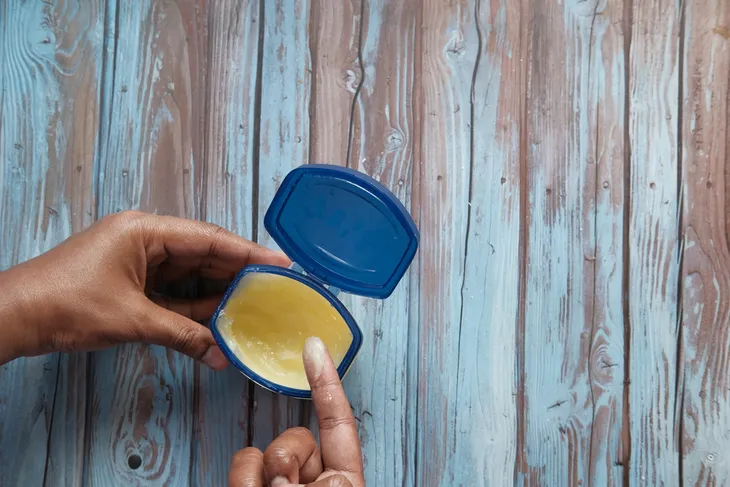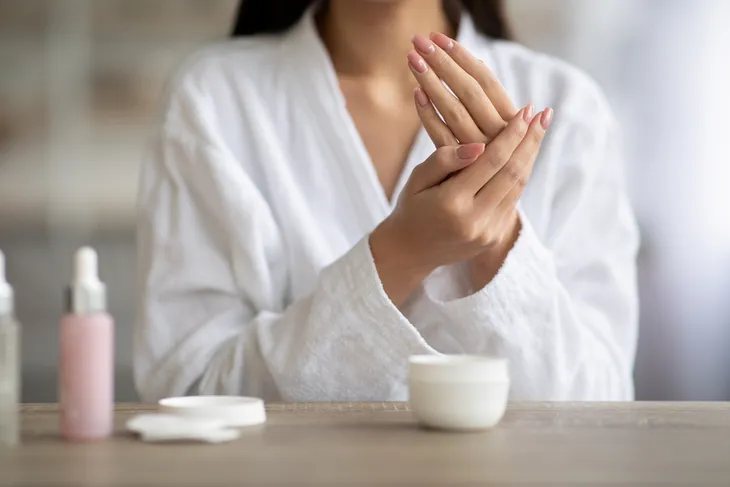- If you’re looking for an inexpensive but effective moisturizer, then petroleum jelly could be a great choice.
- Not only can it help protect and repair the skin, but it also has unexpected household uses in a pinch.
- From hydrating nails to unlocking frozen locks, take a look at the many practical uses of petroleum jelly.
Ever since the late 1800s, petroleum jelly has been a staple in many households. After all, it’s a multi-purpose salve that can make a great addition to your beauty and skincare routine without breaking the bank. And like baking soda and apple cider vinegar, petroleum jelly also has unexpected household uses.
So, let’s get into it and explore the many practical uses of this versatile product. We’ll also explain what petroleum jelly is and look at its potential side effects.
What Is Petroleum Jelly?
There’s a good chance you’ve used petroleum jelly, but do you know what it is exactly? According to Healthline, it’s a semisolid substance made of mineral oils and waxes. The source says petroleum is its main ingredient.
Chemist Robert Chesebrough discovered it in 1859 when he saw oil workers using unrefined petroleum jelly to heal their skin, according to Vaseline. After studying and refining the substance, Chesebrough eventually created a lighter version that he began to sell.
Moisturize Skin and Hair
Petroleum jelly is commonly used to moisturize skin, and it’s easy to see why. For one thing, “ointments are more effective and less irritating than lotions,” according to the American Academy of Dermatology (AAD). The source recommends applying it to damp skin.
It’s also one of the most affordable dry skin remedies, as the Mayo Clinic notes. Additionally, petroleum jelly can help with hair woes. InStyle says a few dabs can moisturize hair and help camouflage split ends.
Hydrate Nails and Hangnails
Petroleum jelly helps moisturize not only skin and hair but also nails. If you frequently paint your nails, then petroleum jelly can provide a little TLC between polishes. The ADA recommends applying it to damp nails and cuticles to help prevent chipping and brittleness.
Petroleum jelly is also an effective home remedy for hangnails. HowStuffWorks says petroleum jelly is an occlusive moisturizer, so it locks in moisture by creating a protective barrier around the hangnail.
Unlock Frozen Locks
While many petroleum jelly uses are skin and beauty remedies, some are unexpected household hacks. For instance, the next time your house or car lock freezes, Colorado Security Products, Inc. suggests using petroleum jelly.
First, coat your key in petroleum jelly. Then, insert the key into the lock and gently wiggle. To help prevent frozen locks, the source also recommends doing a version of this weekly during the winter. Once you’ve dipped the key in petroleum jelly, turn it back and forth a few times in the lock.
Support Skin Healing
Petroleum jelly can also help protect and heal minor skin injuries such as cuts and scrapes, according to the ADA. The source says petroleum jelly helps keep the wound moist, so it’s less likely to form a scab as it heals.
If you deal with eczema outbreaks, then petroleum jelly can help treat the irritated patches of skin. It’s a useful eczema remedy because it protects your skin while it heals. The Healthy recommends “applying a thin layer of petroleum jelly over the affected area.”
Prevent Hair Dye Stains
According to Real Simple, a P&G Beauty Survey found that 65-percent of women aged 15 to 75 dye their hair, and 52-percent of those women exclusively dye their hair at home. If you color your hair at home, then petroleum jelly can be helpful.
The source suggests applying petroleum jelly to your hairline before you begin using dye. That way, the dye won’t get on your skin and leave behind a stain. Simply wipe away the petroleum jelly when you’re done!
Make a Skin Scrub
Looking for an affordable DIY exfoliate? InStyle suggests combining 2-tablespoons of petroleum jelly with 1-tablespoon of sugar to make a face scrub or 2-tablespoons of petroleum jelly with 1-tablespoon of sea salt to make a body scrub.
And if you want to exfoliate your lips, then Vaseline has a recommendation. The source suggests leaving petroleum jelly on your lips for a few minutes. Then, gently scrub your lips with a toothbrush to remove flaky skin.
Lubricate Stuck Objects
Have you ever struggled to take a ring off? It can be frustrating and even painful. Fortunately, HowStuffWorks says, “the ring that just won’t budge is no match for petroleum jelly.” The ring should slide off more easily after you apply a little bit of petroleum jelly.
Petroleum jelly can also help tackle a stuck zipper. Instead of tugging on the zipper, the source suggests applying some petroleum jelly to both sides of the zipper to unstick it.
Treat Diaper Rash
Unfortunately, diaper rash is a common skin problem that many babies experience. According to the Cleveland Clinic, diaper rash is “generally caused by moisture in the diaper area causing a wet environment that promotes bacterial growth.”
Fortunately, petroleum jelly can help. The source says it’s essential to keep the area clean and dry to treat diaper rash. After cleaning the diaper area, the source suggests applying a thick layer of petroleum jelly. If the rash hasn’t healed within 3-days, the source says to talk with a doctor.
Remove Makeup
Sometimes taking makeup off after a long day seems like a chore. But petroleum jelly can make it a smoother process. Healthline says petroleum jelly dissolves makeup gently. So, you can massage some petroleum jelly over your makeup and then use a cotton pad or washcloth to wipe it away.
And if you find makeup stains on clothing or bedding, then Vaseline suggests using petroleum jelly to lift the stains. The source recommends adding petroleum jelly to a damp washcloth. Then, dab the stain until it’s gone.
Soothe Razor Burn
Razor burn can be uncomfortable and unsightly. But HowStuffWorks says petroleum jelly can help take the sting out. In order to soothe razor burn, apply a bit of petroleum jelly to the affected area. After that, the source says the discomfort should fade away.
Healthline says a dull blade can cause razor burn, so it can also help to maintain your razor. Vaseline suggests coating the blades with a thin layer of petroleum jelly between uses to keep the razor in good shape. Just dry the blades first to avoid rust.
Potential Side Effects
Petroleum jelly has a low rate of allergic reactions, according to HowStuffWorks. Even so, NDTV recommends starting with a “patch test to see if it suits you.” To perform the test, Medical News Today suggests applying petroleum jelly to a quarter-sized area of skin. Then reapply twice a day for at least a week.
If your skin reacts negatively, then stop using petroleum jelly. Otherwise, you can feel confident using it after the patch test. While allergic reactions may be uncommon, Healthline says petroleum jelly can cause acne breakouts. So, those with acne-prone skin may want to skip using it on their face.















